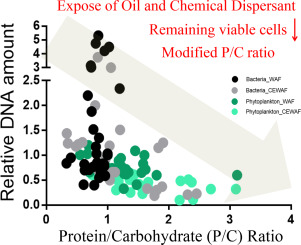Marine Chemistry ( IF 3 ) Pub Date : 2020-03-26 , DOI: 10.1016/j.marchem.2020.103789 Ruei-Feng Shiu , Meng-Hsuen Chiu , Carlos I. Vazquez , Yi-Yen Tsai , Andre Le , Agnes Kagiri , Chen Xu , Manoj Kamalanathan , Hernando P. Bacosa , Shawn M. Doyle , Jason B. Sylvan , Peter H. Santschi , Antonietta Quigg , Wei-Chun Chin

|
Extracellular polymeric substances (EPS) released from marine microbial cells is a major response to stress. Most previous studies focus on the quantity of EPS released from microbes; however, the critical characteristics of EPS composition receive much less attention. Considering the complex nature and diversity of microbes in the marine system also impart distinct behaviors and reactions when exposed to stressful conditions, we cultured four phytoplankton and five bacterial species, to investigate the changes of the chemical composition of EPS under stress from a water-accommodated fraction (WAF) of oil or a chemically-enhanced WAF (CEWAF). Remaining viable cells (DNA amount) of nine marine microbes showed a higher linear negative correlation with increasing protein to carbohydrate (P/C) ratio under CEWAF than WAF treatments. The data also show that EPS with higher protein ratios was released under higher cellular stress levels induced by CEWAF, suggesting that higher protein ratio EPS, which is more hydrophobic, is secreted to physically or chemically ameliorate the hazardous agents. Our findings provide evidence that microbes can actively modify their EPS release and composition in responses to various adverse stress. Collectively, the results support the hypothesis that higher stress not only can trigger more EPS release, but also induce changes in its composition (P/C), thereby affecting environmental processes such as marine oil snow formation and the characteristic of marine organic matter.
中文翻译:

油和Corexit诱导的微生物细胞外聚合物中蛋白质与碳水化合物(P / C)的比率变化
从海洋微生物细胞释放的细胞外聚合物(EPS)是对压力的主要反应。以前的大多数研究都集中在微生物释放的EPS数量上。但是,EPS组成的关键特性却很少受到关注。考虑到海洋系统中微生物的复杂性质和多样性在受到压力条件下也能赋予独特的行为和反应,我们培养了四种浮游植物和五种细菌,以研究在水环境下压力下EPS的化学组成的变化。馏分(WAF)或化学增强的WAF(CEWAF)。与WAF处理相比,CEWAF处理下9种海洋微生物的剩余存活细胞(DNA量)与蛋白质/碳水化合物(P / C)比的增加呈较高的线性负相关性。数据还显示,具有较高蛋白质比率的EPS在CEWAF诱导的较高细胞应激水平下释放,这表明较高蛋白质比率的EPS(疏水性更高)被分泌,以物理或化学方式改善有害物质。我们的发现提供了证据,表明微生物可以响应各种不利压力而主动改变其EPS释放和组成。总的来说,这些结果支持以下假设:较高的压力不仅可以触发更多的EPS释放,而且可以诱导其成分(P / C)发生变化,从而影响环境过程,例如海洋油雪的形成和海洋有机质的特征。可以物理或化学改善有害物质。我们的发现提供了证据,表明微生物可以响应各种不利压力而主动改变其EPS释放和组成。总的来说,这些结果支持以下假设:较高的压力不仅可以触发更多的EPS释放,而且可以诱导其成分(P / C)发生变化,从而影响环境过程,例如海洋油雪的形成和海洋有机质的特征。可以物理或化学改善有害物质。我们的发现提供了证据,表明微生物可以响应各种不利压力而主动改变其EPS释放和组成。总的来说,这些结果支持以下假设:较高的压力不仅可以触发更多的EPS释放,而且可以诱导其成分(P / C)发生变化,从而影响环境过程,例如海洋油雪的形成和海洋有机质的特征。


























 京公网安备 11010802027423号
京公网安备 11010802027423号